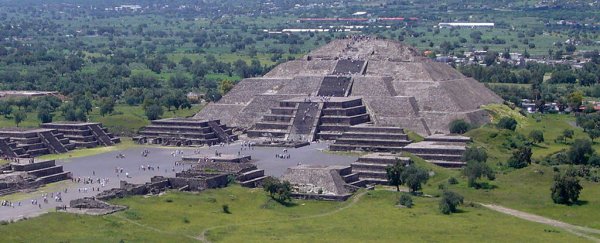It's amazing what the best computer scanning technology can do these days – like revealing a hidden passageway beneath the Pyramid of the Moon near the ancient city of Teotihuacan in Mexico.
The straight tunnel sits about 10 metres (33 feet) underground and is thought to represent a pathway to the underworld, giving us new insight into the culture and rituals of the Teotihuacan people.
Archaeologists from the National Institute of Anthropology and History (NIAH) in Mexico used an imaging technique called electrical resistivity tomography to find the secret tunnel, which can map underground structures (and the gaps inside them) based on how they resist an electrical current.
"The discovery would confirm that the inhabitants of Teotihuacan followed the same pattern in their large-scale temples, and that their function would be to emulate the underworld," one of the archaeologists, Veronica Ortega, told the Associated Press.
The pre-Hispanic Teotihuacan civilisation existed between the 1st and 8th centuries AD, around 40 kilometres (25 miles) north of Mexico City, but there's a lot we don't know about these people and why their community vanished pretty abruptly.
The Pyramid of the Moon itself stands 43 metres (141 feet) high and isn't the only monument on the site: its close neighbours are the Pyramid of the Sun and the Temple of the Feathered Serpent, and archaeologists have found similar tunnels under these buildings too.
The tunnel under the Pyramid of the Sun was found in the 1970s but had been looted centuries before, so experts are hoping this one might have more secrets to reveal, if we ever get down to it.
Archaeologists had better luck with the tunnel under the Temple of the Plumed Serpent, which was opened up and found to contain seeds, pottery, and animal bones.
Now the NIAH team needs to decide whether or not to excavate this site. Opening up the tunnel could reveal a bigger network of passages, and possibly the remains of the ancient city's elite rulers.
More traces of burials and offerings have been found around the Pyramid of the Moon than the other pyramids, so researchers think there could be a lot to explore in the new tunnel. Discoveries found inside it could lead to "a better understanding of the meaning of the city" Ortega says, as TeleSur reports.
It's thought that the people of Teotihuacan saw the underworld as the place where plants, food, and life itself originated – so you can see why this underground realm would be very important to those living on the surface.
The ruins of Teotihuacan obviously have plenty of secrets left to reveal. Last year archaeologists uncovered a 1,600 year-old skull from the site, thought to belong to someone from the upper ranks of the ancient civilisation.
Let's hope the experts decide to dig deeper down into this newly discovered tunnel, because we're intrigued to know what other secrets it might be hiding.
